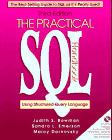Exactly what the Title Implies, a Practical Handbook
Pragmatic, concise, effectively presented, builds on basic concepts through to sophisticated solutions with SQL.
ORIGINAL DRAFT
If you’re looking for a well-crafted non-nonsense way of getting up to speed with SQL, look no further. In its third edition, this book has been refined into a powerful combination of hands-on practice and high-level insights. Whether you are new or experienced with SQL, this is a good investment, with practical examples and good overall coverage of the most common operations. This is a step-by-step book that leads to a deeper understanding of SQL and what you can do with it. The writing style is clear, direct and helps the reader explore the territory with map in hand. As the title suggests, this is, in fact, a practical handbook that lives up to its name.
The book is divided into 12 chapters and a few appendices. Chapter 1 introduces SQL and relational database management. Chapter 2 looks more closely at database design, normalization and implementation. Chapter 3 starts digging into practical SQL statements for creating databases, tables and indexes. Data manipulation is first covered in this chapter, with a look at the update and delete commands. Chapter 4 looks a the select statement, and the where clause, which together represent the key to getting your data back out of a database. More advanced selection and indexing are explored in Chapter 5.
Chapter 6 starts looking at more sophisticated techniques, with a focus on grouping data and reporting. Chapter 7 looks at joining tables for comprehensive data analysis. Chapter 8 has a great look at effective query structuring and substructures. The way you ask for information from a database has a huge impact on the efficiency of a search, something that quickly becomes an issue when the database is large. Chapter 9 looks at working with views. Chapter 10 has a good look at security, transactions, performance and maintaining data integrity. Solving business problems is the focus of Chapter 11 and Chapter 12 provides insights into avoiding common mistakes in SQL.
If you work or plan to work with databases today, you need to be familiar with SQL. Even sophisticated users are likely to gain something from this book, though it is primarily targeted at getting readers up to speed without assuming a great deal of previous knowledge in the field. The early coverage is enough for many users, but the more sophisticated techniques presented as the book progresses are well worth the price of admission. This is a great book to keep on your shelf for occasional review. The material is clear, concise, effectively presented and useful. Highly recommended.
